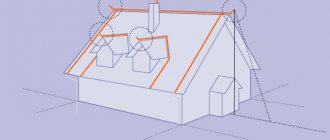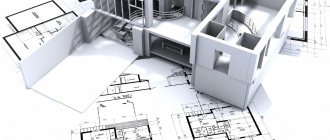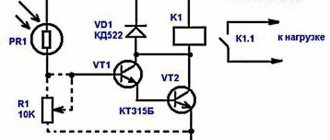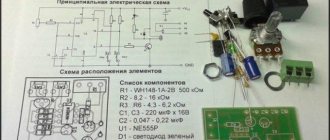Natural lighting of buildings
Natural lighting of premises is mandatory for almost all residential and industrial buildings. After all, it not only provides comfortable living conditions for a person, but also allows you to save on the costs of artificial lighting. But what are its norms and main calculation criteria? We will talk about these aspects in our article.
Types of industrial lighting
Depending on the origin of light, lighting of industrial premises can be natural, artificial or combined. Natural lighting
of natural origin. Direct or reflected sunlight enters a room in different ways: from above, from the side, and both. There are top, side and combined lighting.
Artificial light
is generated by lighting devices and happens:
- workers - used in the direct implementation of activities;
- emergency - provided in case of shutdown of the main equipment;
- security – helping to prevent illegal actions on the territory of the enterprise;
- on duty - intended for non-working hours.
Combined lighting
is generated by the lighting equipment and the sun simultaneously.
Types of Outdoor Lighting
The main purpose of organizing outdoor lighting is to ensure comfort and safety when moving along the streets for both people and vehicles. But don’t forget about the beauty of the surrounding nature. It should be emphasized by competent organization of artificial lighting.
What are its main types?
1. Decorative lighting. This is part of architectural projects, which serves to highlight large objects: parks, bridges, advertising billboards. Its main purpose is to emphasize the beauty of a building or the uniqueness of a landscape.
2. Lighting of private houses and estates. It is important to combine two conditions here:
- provide enough light to allow people to move safely at night;
- do not emit too bright streams so as not to disturb residents’ sleep.
3. Lighting of urban areas. This type of lighting can be divided into several types:
- light for roads and highways;
- light for secondary roads;
- lighting of buildings and structures;
- lighting of sidewalks and pedestrian crossings.
Industrial lighting requirements
The rules for organizing industrial lighting are enshrined in law.
The standards contain requirements for the level of illumination and its uniformity, light brightness and other parameters. First of all, the lighting must match the visual conditions of the work. The relationship between lighting brightness and labor productivity is especially noticeable when interacting with small elements and performing precise operations.
In addition, it is important to achieve an even distribution of light. Visual fatigue increases with frequent gaze shifting from a brightly lit to a darkened object.
The absence of shadows, especially moving ones, as well as fading is another requirement. Both factors reduce visual acuity and increase the likelihood of injury.
Requirements for luminaires for industrial lighting
- The main requirement for lighting devices used in production is their safety. Lamps should not worsen working conditions: make a lot of noise, become noticeably hot, or pose the risk of fire, explosion, or electric shock.
- Fluctuations in illumination, which greatly tire the eyes, are also unacceptable: devices must shine steadily.
- It is important that the light from the devices is distributed correctly and falls on the work surface at an angle of 60 degrees, providing the best visibility.
- Finally, the convenience, reliability, ease of maintenance and energy efficiency of industrial lighting devices are important.
Typically, lighting systems in factories are built on the basis of LED and fluorescent devices, with the former replacing the latter. This is due not only to a long service life and low power consumption, but also to the safety of LED lamps: they do not contain mercury and other harmful elements. Consequently, recycling of failed products costs organizations less.
Conclusion
As you can see, the standards for natural lighting in residential premises and industrial buildings cover a wide range of preparatory work. And this is taking into account the fact that we have not included all the factors taken into account.
After all, the calculation takes into account the reflective ability of the walls and facades of buildings facing opposite, the shading of the premises, the location of workplaces, the operating temperature of the room and much more. All this makes the calculation of the natural lighting of the building one of the fundamental aspects of the entire house.
Even more modern lighting ideas in the photo
Here we will look at some interesting ideas for lighting an apartment.
Examples of organizing lighting in different rooms of an apartment
Also, apartment lighting must take into account the location of certain lamps. Depending on the room, both the power and the method of transmitting the light flux are selected.
Living room, hall
Rice. 8. Lighting in the living room
The whole family gathers in the living room, and on significant dates it is also filled with guests. As a rule, this is the largest room in the apartment, so it is rational to install one central chandelier and several additional devices around the perimeter or in specific areas.
Bedroom
Rice. 9: bedroom lighting
The lighting in the bedroom should not be too powerful, so a chandelier is chosen with closed or diffuse shades so that the light from it predisposes to relaxation and sleep. You can hang a sconce near the bed or install a lamp on the bedside table or place a floor lamp. The bed itself can be equipped with decorative lighting along the contour; one or two spotlights can be placed near the dressing table.
Rice. 10. Illumination of the dressing table in the bedroom
Children's
In children's lighting, lighting is divided into several categories - general, not necessarily powerful, but covering the entire room, setting the background. For the playroom, soft diffused light is provided, providing comfortable play for the child. In the sleeping area, a night light or sconce will come in handy. A powerful lamp is installed near the desktop or directly on it for doing homework and other activities.
Rice. 11. Lighting in the nursery
Kitchen
Several types of lighting are also being developed for the kitchen:
- the common area directly in the center of the active area of the room, is selected so as to provide the dining table with maximum light;
- working - above the table or countertop, where all manipulations are performed, carried out by the most powerful and directed;
- near the stove or hob;
- decorative - around the perimeter of the ceiling or furniture.
Rice. 12. Lighting in the kitchen
Hallway
In the hallway there is no need to use overly powerful lighting devices or complex designer lamps. In this room, both you and your guests arrive for only a few minutes and do not perform any complex actions. Therefore, several spotlights of medium power will be enough. If the hallway is a long corridor, it can be supplemented with a sconce or a spot near the mirror.
Rice. 13. Hallway lighting
Bathroom and toilet
There is no point in installing powerful lighting fixtures in the bathroom, so they use several spotlights around the perimeter of the ceiling. LED lighting is used to highlight any details. As a rule, an adjustable lighting device is located near the mirror for convenience of shaving, applying makeup, etc.
Rice. 14. Bathroom lighting
Fluorescent lamps.
Fluorescent lamps consist of the following main parts (Fig. 3): a glass cylinder, two bases (with lead contacts) at both ends of the cylinder and two heated cathodes (electronic emitters) made of tungsten filament or steel tube. The cylinder is filled with mercury vapor and inert gas (argon); A phosphor coating is applied to the inner walls of the cylinder, which converts the ultraviolet radiation of the gas discharge into visible light. The lamp design shown in Fig. 3, typical for the most common 40 W lamps.
The lamp operates as follows. An electrode at one end of the lamp emits electrons, which fly along the lamp at high speed until they collide with an encountered mercury atom. In doing so, they knock the electrons of the atom into a higher orbit. When the ejected electron returns to its original orbit, the atom emits ultraviolet radiation. The latter, passing through the phosphor, is converted into visible light.
Electroluminescent lamps.
Unlike fluorescent lamps (in which light is emitted when a phosphor is excited by ultraviolet radiation from a gas discharge), electroluminescent lamps, invented in 1936, convert electrical energy directly into light through the use of special phosphors. The lamp is a multilayer structure consisting of a layer of phosphor (zinc sulfide, activated by copper or lead) and two electrically conductive plates, one of which is transparent. The design of two types of electroluminescent lamps is shown in Fig. 5. The color of the lamp (blue, green, yellow or pink) depends on the frequency of the supply voltage, and the brightness depends on the frequency and voltage. Electroluminescent lamps do not yet have high luminous efficiency. See also ELECTRIC VACUUM AND GAS DISCHARGE DEVICES.
Types of outdoor lighting fixtures
Lantern lamps that are used for outdoor use can be classified according to their type:
- gas lamp;
- incandescent lamps;
- oily based;
- with multiple arc lamps;
- LEDs;
- induction lamps.
When choosing street lights, you must consider the following 4 criteria:
- Compliance with standards and requirements. It is important not only to pay attention to light levels, but also to the type and quality of supports. An outdoor lantern should provide a clear view of the entire area, regardless of its placement.
- Ensuring the safety of traffic and pedestrians.
- Aesthetic appeal. The lantern should not only solve functional problems, but also perform an architectural function - harmoniously combine with the facade of the house.
- Long service life.
- Energy saving.
Online test “Do you have a knack for interior design?”
Take the test










